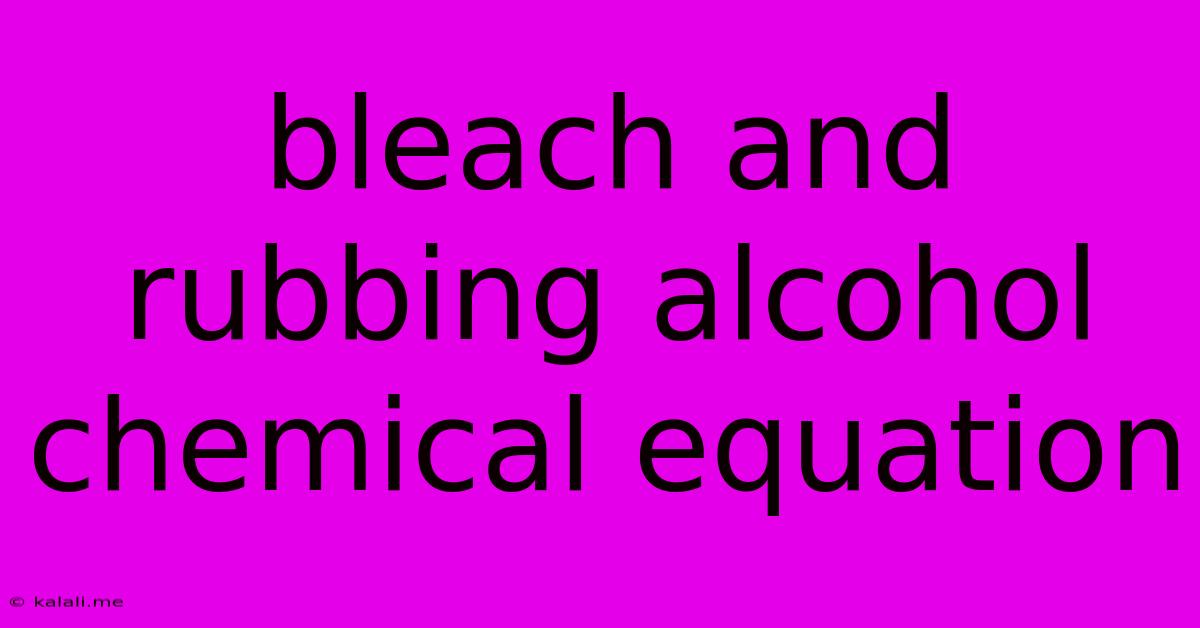Bleach And Rubbing Alcohol Chemical Equation
Kalali
Jun 04, 2025 · 3 min read

Table of Contents
The Chemistry of Bleach and Rubbing Alcohol: A Dangerous Mix
Meta Description: Mixing bleach and rubbing alcohol is incredibly dangerous and creates toxic gases. This article explores the chemical reactions involved, highlighting the risks and safety precautions. Learn why you should never combine these household cleaners.
Mixing household cleaning products is never a good idea, and the combination of bleach and rubbing alcohol is particularly hazardous. This isn't just a matter of a slightly unpleasant smell; it produces toxic and potentially lethal gases. Understanding the underlying chemical reactions is crucial to appreciating the severity of the dangers involved. This article will delve into the chemistry behind this dangerous mix and explain why you should absolutely avoid it.
The Chemical Components
Before exploring the reaction, let's identify the key players:
-
Bleach (Sodium Hypochlorite): The active ingredient in bleach is sodium hypochlorite (NaClO). It's a powerful oxidizing agent, meaning it readily accepts electrons from other substances. This is what gives it its bleaching and disinfecting properties.
-
Rubbing Alcohol (Isopropyl Alcohol): Commonly used rubbing alcohol is isopropyl alcohol (C₃H₈O), also known as 2-propanol. It's a relatively simple alcohol with antiseptic and disinfectant properties.
The Dangerous Reaction
When bleach and rubbing alcohol are mixed, a complex reaction occurs, producing several hazardous compounds. While the precise reaction isn't a single, easily defined equation, the key outcome is the formation of chloroform (CHCl₃) and other potentially dangerous chlorinated compounds. The reaction is facilitated by the oxidizing power of the hypochlorite ion in bleach. This oxidation process involves the breakdown of isopropyl alcohol, leading to the generation of chloroform and other volatile organic compounds (VOCs).
The exact chemical equations are complex and depend on several factors, including concentration, temperature, and pH. However, the overall process involves the oxidation of isopropyl alcohol by the hypochlorite ion, resulting in the formation of chloroform and other byproducts. The generation of chloroform is particularly concerning due to its known toxicity and carcinogenic properties.
The Dangers of Chloroform and Other Byproducts
Chloroform is a volatile, colorless liquid with a sweet odor. While it has historically been used as an anesthetic, it's now recognized as a potent hepatotoxin (liver toxin) and a suspected carcinogen. Inhalation of even small amounts can cause dizziness, headaches, nausea, and unconsciousness. Long-term exposure can lead to more severe health consequences.
The other byproducts of this reaction are also likely to be toxic and irritating. These VOCs can contribute to respiratory problems, eye irritation, and other health issues.
Safety Precautions: Never Mix Bleach and Rubbing Alcohol
The information provided above underscores the critical importance of never mixing bleach and rubbing alcohol. The resulting toxic gases pose significant health risks. Always follow the instructions on cleaning product labels and ensure proper ventilation when using any cleaning chemicals. If you accidentally mix these substances, immediately evacuate the area and ensure fresh air circulation. Contacting emergency services or poison control is also advisable.
Remember, safety should always be your top priority when handling cleaning products. Using each product individually and according to its instructions is significantly safer than attempting to combine them.
Latest Posts
Latest Posts
-
S Corp Capital Gain Vs Personal Capital Gain
Jun 06, 2025
-
Total Internal Reflection Fibre Optics Bends
Jun 06, 2025
-
Bow Saw To Cut Intricate External Sapes
Jun 06, 2025
-
Do Frogs Swim On Their Backs
Jun 06, 2025
-
Why Are Clouds Flat On The Bottom
Jun 06, 2025
Related Post
Thank you for visiting our website which covers about Bleach And Rubbing Alcohol Chemical Equation . We hope the information provided has been useful to you. Feel free to contact us if you have any questions or need further assistance. See you next time and don't miss to bookmark.